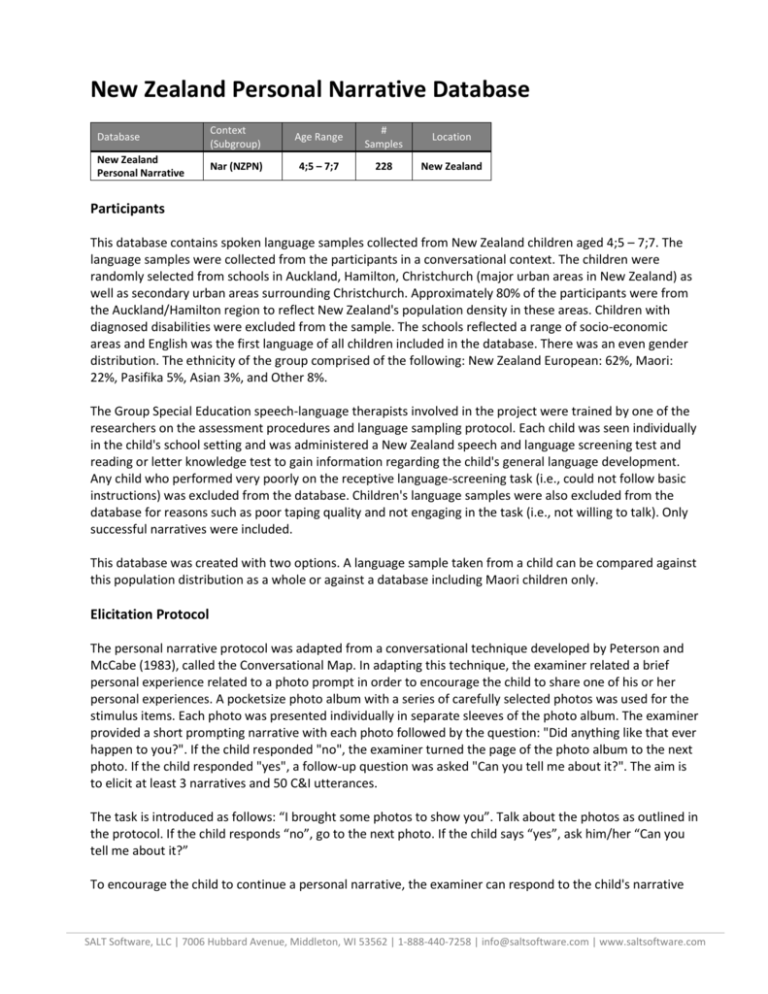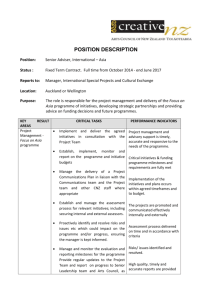New Zealand Personal Narrative Database
advertisement

New Zealand Personal Narrative Database
Database
Context
(Subgroup)
Age Range
#
Samples
Location
New Zealand
Personal Narrative
Nar (NZPN)
4;5 – 7;7
228
New Zealand
Participants
This database contains spoken language samples collected from New Zealand children aged 4;5 – 7;7. The
language samples were collected from the participants in a conversational context. The children were
randomly selected from schools in Auckland, Hamilton, Christchurch (major urban areas in New Zealand) as
well as secondary urban areas surrounding Christchurch. Approximately 80% of the participants were from
the Auckland/Hamilton region to reflect New Zealand's population density in these areas. Children with
diagnosed disabilities were excluded from the sample. The schools reflected a range of socio-economic
areas and English was the first language of all children included in the database. There was an even gender
distribution. The ethnicity of the group comprised of the following: New Zealand European: 62%, Maori:
22%, Pasifika 5%, Asian 3%, and Other 8%.
The Group Special Education speech-language therapists involved in the project were trained by one of the
researchers on the assessment procedures and language sampling protocol. Each child was seen individually
in the child's school setting and was administered a New Zealand speech and language screening test and
reading or letter knowledge test to gain information regarding the child's general language development.
Any child who performed very poorly on the receptive language-screening task (i.e., could not follow basic
instructions) was excluded from the database. Children's language samples were also excluded from the
database for reasons such as poor taping quality and not engaging in the task (i.e., not willing to talk). Only
successful narratives were included.
This database was created with two options. A language sample taken from a child can be compared against
this population distribution as a whole or against a database including Maori children only.
Elicitation Protocol
The personal narrative protocol was adapted from a conversational technique developed by Peterson and
McCabe (1983), called the Conversational Map. In adapting this technique, the examiner related a brief
personal experience related to a photo prompt in order to encourage the child to share one of his or her
personal experiences. A pocketsize photo album with a series of carefully selected photos was used for the
stimulus items. Each photo was presented individually in separate sleeves of the photo album. The examiner
provided a short prompting narrative with each photo followed by the question: "Did anything like that ever
happen to you?". If the child responded "no", the examiner turned the page of the photo album to the next
photo. If the child responded "yes", a follow-up question was asked "Can you tell me about it?". The aim is
to elicit at least 3 narratives and 50 C&I utterances.
The task is introduced as follows: “I brought some photos to show you”. Talk about the photos as outlined in
the protocol. If the child responds “no”, go to the next photo. If the child says “yes”, ask him/her “Can you
tell me about it?”
To encourage the child to continue a personal narrative, the examiner can respond to the child's narrative
SALT Software, LLC | 7006 Hubbard Avenue, Middleton, WI 53562 | 1-888-440-7258 | info@saltsoftware.com | www.saltsoftware.com
New Zealand Personal Narrative Database
2|Page
by:
Repeating the exact words of the children when they pause
Using relatively neutral sub-prompts, such as "uh-huh"
Saying "tell me more"
Asking "and then what happened?"
It is very important that the examiner does NOT evaluate the child's narrative. This gives the children the
opportunity to demonstrate what they can do on their own.
Transcription Notes
The utterances were segmented into communication units (C-units). A C-unit includes an independent
clause with its modifiers (Loban, 1976). All transcripts were timed and pauses, within and between
utterances, of two or more seconds in length, were marked. Age and gender information is included for all
participants.
The prompts were transcribed from (and including) the examiner's question that leads to a "yes" response
from the child. E.g., with the first prompt (McDonald's), only transcribe the underlined italicised utterances:
Oh look who's this? I went to a birthday party at McDonald's last year. Have you ever been to McDonald’s?
Child responds Yes or {Nods}. What happened last time you went to McDonald’s?
The following plus lines were inserted as part of the header information:
+ Context: Nar
+ Subgroup: NZPN
+ Ethnicity: Maori (only included for Maori subset)
When comparing samples to this database, you have the option of restricting the comparison to the Maori
subset.
Acknowledgements
The New Zealand databases are a result of the collaboration with Gail Gillon and Marleen Westerveld from
the Department of Communication Disorders, University of Canterbury. Speech-language therapists from
Group Special Education in Auckland, Hamilton, Christchurch and Canterbury districts in New Zealand were
involved in the collection of the language samples. The New Zealand Ministry of Education allowed the
participation of Special Education speech-language therapists in the project. Financial assistance for the
project was provided by the University of Canterbury, The Don Bevan Travel Scholarship, and the New
Zealand Speech Language Therapists' Association.
Photos Used to Elicit Personal Narratives
You can download the photos used to elicit the samples from the SALT Web site at
www.saltsoftware.com/resources/.
SALT Software, LLC | 7006 Hubbard Avenue, Middleton, WI 53562 | 1-888-440-7258 | info@saltsoftware.com | www.saltsoftware.com







